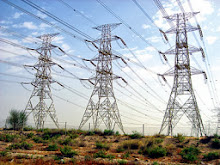Series-Wound DC Generators
Series-Wound DC Generators
When the field winding of a DC generator is connected in series with the
armature, the generator is called a series-wound generator (Figure 1).
The excitation current in a series-wound generator is the same as the
current the
generator delivers to the load. If the load has a high resistance and
only draws a small amount of current, the excitation current is also
small. Therefore,
the magnetic field of the series field winding is weak, making the
generated voltage low. Conversely, if the load draws a large current,
the excitation current is also high. Therefore, the magnetic field of
the series field winding is very strong, and the generated voltage is
high.
 |
| Figure1 Series-Wound DC Generator |
As you can see in Figure 2, in a series generator, changes in load
current drastically affect the generator output voltage. A series
generator has poor voltage regulation, and, as a result, series
generators are not used for
fluctuating loads. As is the case for the shunt-wound generator, a
series-wound generator also exhibits some losses due to the resistance
of the windings and
armature reaction. These losses cause a lower terminal voltage than that
for an ideal magnetization curve.
 |
| Figure 2 Output Voltage-vs-Load Current for Series-Wound DC Generator |











0 comments:
Post a Comment